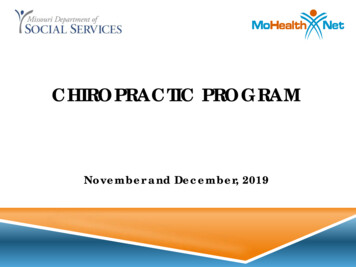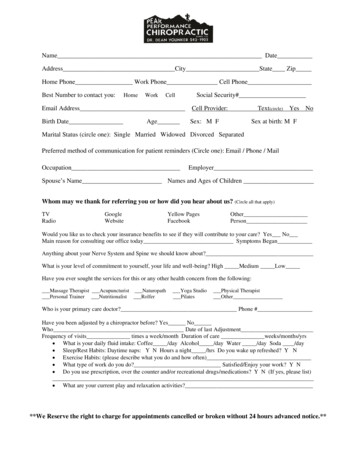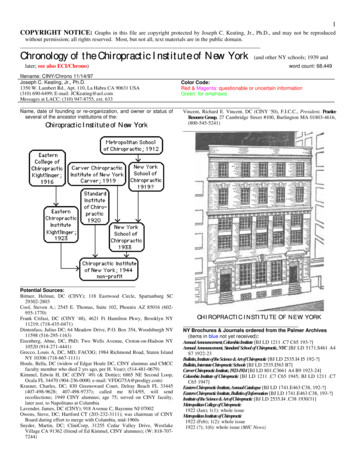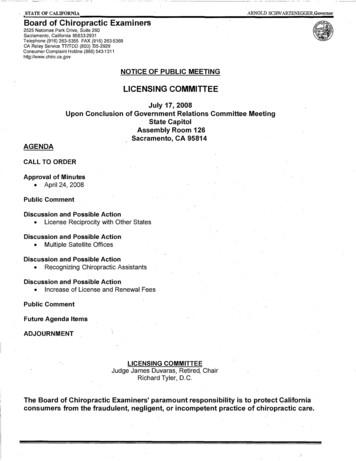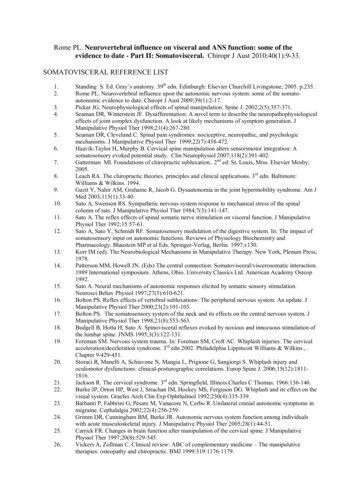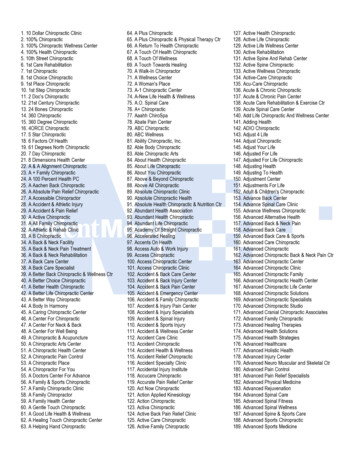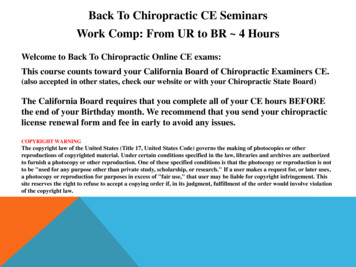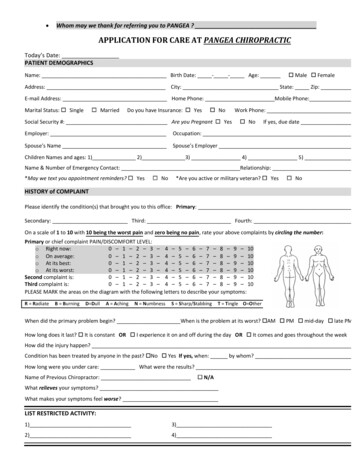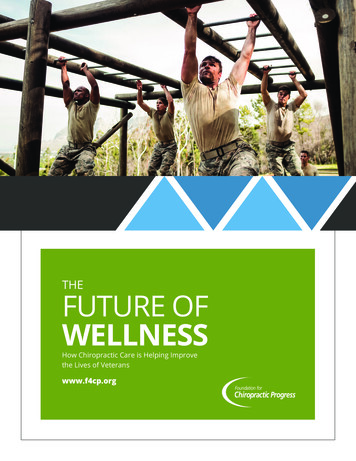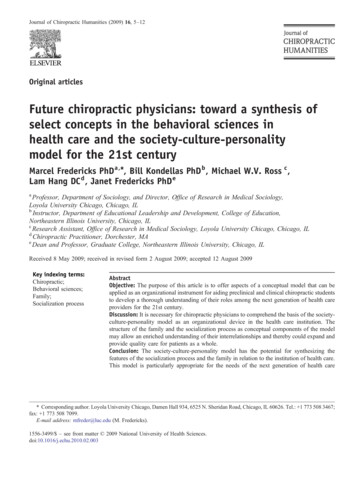
Transcription
Journal of Chiropractic Humanities (2009) 16, 5–12Original articlesFuture chiropractic physicians: toward a synthesis ofselect concepts in the behavioral sciences inhealth care and the society-culture-personalitymodel for the 21st centuryMarcel Fredericks PhD a,⁎, Bill Kondellas PhD b , Michael W.V. Ross c ,Lam Hang DC d , Janet Fredericks PhD eaProfessor, Department of Sociology, and Director, Office of Research in Medical Sociology,Loyola University Chicago, Chicago, ILbInstructor, Department of Educational Leadership and Development, College of Education,Northeastern Illinois University, Chicago, ILcResearch Assistant, Office of Research in Medical Sociology, Loyola University Chicago, Chicago, ILdChiropractic Practitioner, Dorchester, MAeDean and Professor, Graduate College, Northeastern Illinois University, Chicago, ILReceived 8 May 2009; received in revised form 2 August 2009; accepted 12 August 2009Key indexing terms:Chiropractic;Behavioral sciences;Family;Socialization processAbstractObjective: The purpose of this article is to offer aspects of a conceptual model that can beapplied as an organizational instrument for aiding preclinical and clinical chiropractic studentsto develop a thorough understanding of their roles among the next generation of health careproviders for the 21st century.Discussion: It is necessary for chiropractic physicians to comprehend the basis of the societyculture-personality model as an organizational device in the health care institution. Thestructure of the family and the socialization process as conceptual components of the modelmay allow an enriched understanding of their interrelationships and thereby could expand andprovide quality care for patients as a whole.Conclusion: The society-culture-personality model has the potential for synthesizing thefeatures of the socialization process and the family in relation to the institution of health care.This model is particularly appropriate for the needs of the next generation of health care⁎ Corresponding author. Loyola University Chicago, Damen Hall 934, 6525 N. Sheridan Road, Chicago, IL 60626. Tel.: 1 773 508 3467;fax: 1 773 508 7099.E-mail address: mfreder@luc.edu (M. Fredericks).1556-3499/ – see front matter 2009 National University of Health Sciences.doi:10.1016/j.echu.2010.02.003
6M. Fredericks et al.professionals (chiropractic physicians, physicians, dentists, nurses, and osteopathicphysicians) who may not have had the chance to be exposed entirely to the behavioralsciences in health care. 2009 National University of Health Sciences.IntroductionAt present, the behavioral sciences have beenaccorded an essential, even vital place in theeducation of future chiropractic physicians, physicians, dentists, nurses, administrators, and directors.Indeed, the collaborative inclusion of the behavioral sciences and other disciplines in the professionalization process of health care workers hasbeen well documented by the former dean ofHarvard Medical School. He asserted that “collaboration . . . could be a universal starting point foraccelerating our slow march toward global equityin health care.” 1An important criterion, therefore, in the teaching ofbehavioral sciences to health care students for theirfuture professional roles as caregivers is to place thediverse body of descriptive and empirical findingswithin some type of theoretical framework. Thiscontext should incorporate essential concepts andtheories from the various disciplines, for example,sociology, psychology, and anthropology, in such away as to show the interconnectedness of centralissues surrounding health care as an institution insocieties. Indeed, to be ill is not merely a medicalproblem; it is also a social event involving more than1 person and changing the sick person's customaryrelationships with others in the family, in thecommunity, and ultimately in society.This article will attempt to present aspects of aconceptual model that can be used as an organizationaldevice for assisting preclinical and clinical chiropractic students to develop a greater comprehension oftheir future professional roles as health care practitioners in communities and societies nationally andtransculturally. We shall present aspects of the societyculture-personality (SCP) model and the health careinstitution from the perspectives of (a) the socialization or learning process especially as health behavior,illness behavior, and the sick role are all learnedbehaviors; and (b) the institution of the family as thefamily is “the unit of medical care because it is theunit of living.”2 The use of this model has beenpresented elsewhere. 3-6The socialization process of the SCP modeland the health care institutionThe SCP model forms an interlocking social system(Fig 1). By definition, a social system is a pattern ofexpected behaviors associated with a certain position insociety. As roles become highly complex structures,they are called institutions (ie, ways of taking care ofbasic human needs). In brief, institutions are sociallyapproved patterns of behavior. Health care and thefamily are viewed as institutions in American society.The various institutions of a society are crescive innature and have a strain of consistency, which simplymeans that they develop over time and they are allinterrelated. Health care as an institution, therefore,cannot be fully understood unless it is examined initself as well as in relation to other institutions such asthe family, social welfare, government, education,religion, and other organizational structures in thesociety. A society, from one perspective, can be viewedas falling somewhere between two polar pure types,ideal types or mental constructs as either gemeinschaftor gesellschaft in orientation, or perhaps rural andurban (Fig 1).The SCP model from a macroscopic perspectiverepresents the global village, a nation, a community, aninstitution or group (Fig 1). There are a multitude ofsubsystems, comparable with subsystems in the humanbody, operating in any of these aggregates.For purposes of analysis, we will isolate a simplesubsystem, namely, the personality subsystem. Thissubsystem involves the socialization or learningprocess (SP); nature (N1), which is the genetic basis,and nurture (N2), or environment, which is the social orcultural basis in any society between the gemeinschaft(G1) and the gesellschaft (G2) dichotomy (Fig 1).The genetic (or natural) basis of personality is thecombination of traits that results from the person'sunique constellation of genes. The genetic basis (N1) ofpersonality represents only potentiality. These potentialities, when developed under the influence of the totalenvironment in which the individual's orientation takesplace, are shaped into a personality. Hence, theformation of the personality is one of integrating the
Toward a synthesis of select concepts7Fig 1. Society-culture-personality (SCP) and the health care institution. SCP, global village; S, society; C, culture; P,personality; N1, nature or heredity; N2, nurture or environment; G1, gemeinschaft; SP, socialization process; G2, gesellschaft; M,marginality; A, anomie; SS, social systems; R, role; I, institution; HCG, health care givers.individual's experience with his or her physicalqualities to form a mutually adjusted, functioningwhole. This takes place in childhood and adolescenceand results in the development of distinctive physical aswell as emotional responses. The personality system,therefore, is the totality of the actor's personal needs inthe cultural world in which he or she interacts. Withinthe personality system rests the self-concept. The self-Fig 2. Society-culture-personality (SCP): Socialization and health care. S, society; C, culture; P, personality; N1, nature; N2,nurture; G1, gemeinschaft; G2, gesellschaft; SP, socialization processes; M, marginality; A, anomie; SS, social systems; R, role; I,institution; X, conception; D, death; HB, health behavior; IB, illness behavior; SR, sick role; SMI, socially meaningful interaction.
8concept involves the assumption that personalities actaccording to the way they perceive themselves (theirself-concept) and according to the way they perceivethe social situation. Social situations are all forcesacting upon the individual at any given moment in time.The assimilation process is most crucial in thepersonality system. The finished product is acquiredthrough socially meaningful interaction (SMI)—thenucleus of the cell of society. The SMI is linked tosocialization, a learning process in a social environment(N2), where the value-attitude system (VAS) of aculture is internalized (Fig 2).The socialization process is linked to the health caresystem through health behavior, illness behavior, andthe sick role. These behaviors are learned behaviors.They permeate the life cycle from the moment ofconception until natural death (Fig 2). The life cyclecan be viewed in terms of the prenatal (from conception[X] to birth) and postnatal from birth to natural death(D) (Fig 2).In the prenatal stage, the brain and nervous systemdevelop and form an intricate network. This networkcan be interrupted by environmental factors such asfetal exposure to alcohol or drugs used by the mother. Ifsuch interruption occurs, certain ailments can affectapproximately 10 000 U.S. babies a year. Fetal alcoholsyndrome (FAS) can lead to serious mental retardationcaused by maternal alcohol abuse. Research indicatesthe fact that 1200 to 8000 FAS babies are born annuallyin the United States. 7During the socialization process in the life cycle,children born into poverty struggle against serious oddsto achieve optimal health and well-being. Lifestylesand health behaviors are developed by the communityin which the child may live. For instance, persistentexposure to poverty and other social problems, familyviolence, and alcohol abuse increases a child's chancesof adopting similar behavioral patterns. 7 On the whole,children socialized in poverty may be at greater risk forpoor health. Children who are born to single motherswho may be homeless, and may have poor educationalattainment, may put the infant at similar risk forinadequate health care and poor access to preventiveand health care services. As a result, the mother and theinfant may both be affected by insufficient health carein impoverished neighborhoods and societies. 8In the socialization process of the postnatal stage ofthe life cycle, it is to be noted that living incommunities with high levels of air pollution isdirectly related to an increased incidence of respiratoryillnesses in children. Children who live in certainenvironments surrounded by nuclear power plants and/M. Fredericks et al.or toxic waste sites are at greater risk of variousillnesses especially as their bodies are still in theprocess of development. These children may experience extreme challenges in receiving adequate healthcare because of lack of health insurance. 8Indeed it is to be noted that people who live inpoverty receive suboptimal health care. For example,children who are poor are twice as likely to be in poorhealth, and they have a greater probability of beinghospitalized for short periods of time (Fig 2).9 In thepostnatal stage of the life cycle (Fig 2), the socializationprocess in relation to the health care institution is linkedto several behavioral science theories such as Cooley'slooking-glass self. 10 This theory and others are mostapplicable to therapists in the health care system. In thearea of gerontology, the activity and disengagementtheories play vital roles in the lives of the elderlyirrespective of the location of the society and culture onthe continuum between the gemeinschaft and gesellschaft dichotomy (Fig 2).The socialization process in relation to the healthcare institution is most helpful in the diagnosis,treatment, and prognosis of several illnesses anddisorders. The following illustrate just some of thesocial and psychological issues confronting Americans.For example, 10% of the U.S. adult populationexperiences a depressive disorder. Additionally, anxiety disorders are a most prevalent group of psychiatricillnesses among children and adults. Other commondisorders include dyslexia, which is revealed when achild learns to read, and antisocial behavior, whichinvolves behaviors from lying and bullying to vandalism and homicide. It should be noted that antisocialbehaviors, however, are most prevalent in boys whotend to inflict physical harm on others. Eatingdisorders, however, are ailments that are most commonin American teenage girls and young women as only5% to 15% of anorexics or bulimics and 35% of bingeeaters are male.9Given the above, the concept of the socializationprocess in the behavioral sciences in health care isdirectly related to the SCP model especially from theperspective of poverty in the United States and aroundthe world. According to William Spencer, the following statistics give us an indication how widespread thepoverty crisis is in the United States. He asserted that:37.3 million people live in poverty in the UnitedStates. This includes 10 percent of families . . . Thechild poverty rate in the U.S. is 18%, between twoand four times higher than other major industrialized nations. One in six children in the U.S. livesin poverty. The poverty rate for America's
Toward a synthesis of select conceptspopulation over 65 stands at 9.7 percent, or one inten seniors. At 16 million, the greatest number ofpoor persons are non-Hispanic white Americans.11The same study shows that poverty, however, is notonly a socioeconomic issue facing the United States butalso the international community as well. The findingsdemonstrate that:An estimated 1.4 billion of the world's people livein extreme poverty, on under 1.25/day. Over 2.6billion people live on 2 a day. Countless otherslive just above the poverty line and remain highlyvulnerable to crises. 40 million people were pushedinto hunger in 2008 due to higher food prices. Onequarter of all children in developing countries areat risk of experiencing long-term effects of undernourishment. Over 1 billion people do not haveaccess to sanitation, and over 30,000 children dieof preventable diseases every day.11We shall now consider a synthesis of additionalconcepts and theories within the institutions of thefamily and health care in relation to the SCP model.The family, health care, and the SCP modelThere is no human society in which some form offamily does not exist. The family is the most permanentof all social institutions and fundamental to thesocialization process of the individual. The family is,without question, the oldest and most prevalent of allhuman institutions. The family is related to health by thefact of biological inheritance of some disease entities.Diseases such as sickle cell anemia, Rh factor incompatibility, and tendencies to diabetes, tuberculosis, andpoor dentition are examples of entities passed by thefamily through the gene pool. Heredity is responsible fordarker teeth with translucent appearance. Teeth that aredarker lose their enamel easily when compared withnormal teeth and are more likely to wear down to the gumline.8 Indeed, the “family is the unit of medical carebecause it is the unit of living.”2The family has several functions. For example, itacts as a biological and social heritage from onegeneration to another. However, one undisputedfunction of the family is the socialization of its nucleusinto the society. In general, the term socialization isused to describe the ways in which the individual learnsthe values, beliefs, and roles that underwrite the socialsystem in which he or she participates.9The sick role developed in the socialization process ismost important in physical and mental disorders. Forexample, a patient may act out his or her sick role inrelation to the members of a health care team(chiropractic physicians, physicians, administrators,nurses, the chaplain, his family, osteopathic physicians)and the other members of society in the manner in whichhe or she has internalized this role from infancy (Fig 3).Family roles can be seriously affected by illness,bringing about a reshaping of roles and role responsibilities. Role reversal between parents is a commonone, in which the breadwinner's responsibility isswitched and patterns of child care may need tochange. For example, if a longshoreman loses his legthrough an on-the-job accident, he will no longer beable to act out his occupational role as the use of bothlegs would be necessary for him to perform his worksuccessfully. His wife will now become the breadwinner and he becomes the homemaker. These transitionscan be sources of confusion in identity for childrenduring the early developmental stages especially ifthere had been prior inadequate role performances onthe part of the parents toward their children.The family also influences health care through itseffects on nurture (N2) or environment of the individual(Fig 3). A family of 10 who is crowded into an inadequatehome without sufficient heat and enough finances forbalanced meals will be more likely to become ill, and theindividual's view of health will reflect his or herexperience under such living conditions.In an early study, Komarovsky examined family lifein Newark during the Great Depression of the 1930s todetermine the impact the father's unemployment hadon familial roles.12 She found that the loss of thebreadwinner's role sometimes had serious and tragiceffects on the man's self-esteem and on his formerlyaffectionate and authoritative relationships with hiswife and children. In such cases, husbands viewedthemselves as humiliated and came to feel neuroticbecause of so much free time and nothing to do; wiveswere bitterly disappointed at their husbands' sociallydefined economic failure.Given the role of the family in relation to health care,we will turn our attention now to the structure of thefamily to grasp a better understanding of the interdependence of these two institutions in the SCP model (Fig 3).Structure of the family in health careEvery social institution has some sort of structure orframework that helps to put concepts or purposes of the
10M. Fredericks et al.Fig 3. Society-culture-personality (SCP): The family and health care. S, society; C, culture; P, personality; N1, nature; N2,nurture; G1, gemeinschaft; G2, gesellschaft; M, marginality; A, anomie; SS, social systems; R, role; I, institution; SP,socialization processes; SR, sick role; SMI, socially meaningful interaction.institution into the world of action so that it can serve theinterest of society and the members who compose it. Thefamily as a social institution has its framework orstructure within which it can carry out the purposes forwhich it exists. Most individuals are members of twofamilies during their lives. The first is the family of origin(orientation) in which our earliest experiences take place.The second is the family of marriage (or procreation) inwhich we may enact the role of parent. It is within thenetwork of familial relationships that we develop ourattitudes and values toward health and illness. Attitudesare tendencies to feel and act in certain ways. Values, onthe other hand, are measures of desirability. The structureof the family can be classified as shown in Fig 3.The family as we have noted earlier is the mostuniversal of all human institutions. It varies widely instructure from the consanguinal type (ie, extended kingroups, which include a wide variety of relatedpersons) to conjugal families consisting simply of anadult pair (male and female) and their children. Theconjugal family acts as a source of “refuge” in masssociety—a place where the individual may engage ingenuinely personal relationships in a world that islargely impersonal.In the past, many authors have given us a descriptionof different types of families. Sorokin, for examplepresents 3 types: namely, the compulsive, the contractual, and the familistic (Fig 3). In the compulsive family,the bond holding members together is not love but forceand the relationship is based on exploitation, cruelty, anddeprivation. The contractual type brings profit andadvancement to the participants but is devoid of loveand hatred. The familistic type is based on mutual lovebetween the spouses, and it is characterized by devotion,sacrifice, solidarity, sharing, permanence, and stability.Sorokin feels that the 3 types of families have beenpresent regardless of one's society but have changed inproportion with time. The contractual family, however, isthe largest one in today's Western world.13The type of family a person comes from can help usunderstand the behaviors of the patient and members ofthe family toward the sick person. For example, in severecoronary cases, increasing demands are made on thefamily to adjust their customary routines to the patient'sneeds. One can expect, therefore, that if the family typewas close (familistic), in which each member wasconcerned about the others prior to the illness, then therecould be a greater willingness for members of the familyto adjust their roles to help the sick person. On thecontrary, if the family type was contractual and/orcompulsive, then the family members would be lesswilling to make the sacrifices to aid the sick individual.Structure within the institution of the family plays anessential role in the way stress is handled during asudden crisis. The outcome of such a crisis will dependupon the type of familial relationship prior to theepisode. For example, stress within a family may leadto infectious illness. Research done at the Family
Toward a synthesis of select conceptsMedicine Unit at Harvard Medical School havedemonstrated rather clearly that:. . . Common crises such as death of grandparents,change of residence, a loss of a father's job, and achild's being subjected to unusual pressure, occurfour times more frequently in the two week periodprior to the appearance of streptococcal infectionthan in the two weeks afterward.14The same studies have shown that:Age, intimacy of contact, and family organizationinfluenced the susceptibility to streptococcal infection. Children of school age were most susceptible,and a spread of infection to other family memberssharing the same bedroom was likely. Chronic familydisorganization also was correlated with susceptibility to infection.14Additional research demonstrates that “streptococcaland staphylococcal infections are family disorders, andsuccessful management responses requires consideration of the family group.” 15Another kind of crisis in which the type of familyplays an important role is the biological inheritancefactor. If one learns that he or she is a cause of diseasethat affects children or learns that he or she is a recipientof a disease of a familiar nature, this knowledge canbring about complicated emotional problems in familyinteraction. For example, the birth of a deformed infantmay be accompanied by a guilt reaction on the part ofboth parents. One can speculate about the emotionaldisturbances of the family in the specific case ofmuscular dystrophy, which is carried by the female andattacks the male. The need of a parent to denyknowledge about such discomforting facts is understandable; however, there is a tendency for the parent tobelieve the facts must be disproved and to continuallyseek out advice in order to get different answers. At thisstage of the crisis, there is a great need to see the familyas a unit of treatment. Whether or not the family isviewed as such will depend partially upon the type offamilial relationships prior to the episode.Another important role of the family is the patientphysician relationship concerning the care at the end oflife. Though many health care professionals are oftenuncomfortable discussing death and dying with theirpatients and families and believe such discussion wouldbe too difficult emotionally and thus ineffective for thepatient and family, a recent study has shown that thereverse is true. Almost 90% of caregivers (ie, the family)believe such collaboration was not stressful, and 20%found it beneficial.16 The burden of caregiving on the11family is often substantial. Family members who arethemselves elderly, ill, and disabled often performcaregiving. It can be the equivalent of a full-time jobfor 20% of caregivers and result in further financialburden. The average annual costs for caregiving in theUnited States can range from 3 billion to 6 billion.17These stressors often lead families to seek long-termcare (LTC) placement. Several patient and caregivercharacteristics are predictors of future placement. Caregivers who are older (N65 years of age) who feel a greatersense of burden are more likely to have their loved one ina LTC facility.18 Although many caregivers experiencesymptoms of anxiety and depression (15% to 20%) priorto placement in an LTC facility, these symptoms did notchange after placement, particularly true for spouses.19Two recent studies found that caregivers often experiencea sense of relief after the passing of a loved one, when itwas preceded by ongoing suffering and significantburden to the caregiver.20,21 One study suggests that, inaddition to the known risk of psychiatric morbidity ofcaregiving, there is a 60% higher risk of caregiver deathwhen compared with non-caregiver controls. 22 Inrecognizing the burden of caregiving, Rabow et alrecently proposed 5 areas of opportunities for caregiversto be of service to the family. These are (a) promotecommunication, (b) promote advanced care planning anddecision making, (c) support home care, (d) demonstrateempathy for patients and their families, and (e) participatein family grief and bereavement. In providing compassion and empathy, caregivers have much to offer topatients and their families.ConclusionWith the inclusion of the behavioral sciencescomponent in the National Board Examinations,many professional schools in the health care institutionhave included sociology, psychology, and anthropology in the training of their students. However, theextreme shortage of qualified social scientists, who arecapable of relating the behavioral sciences to the healthcare institution, makes it difficult to meet the needs ofgraduate and professional schools everywhere. In viewof this problem, this article has synthesized 2conceptual frameworks, the socialization process andthe institution of the family, with the SCP model. TheSCP model is an organizational device for integratingthe components of the socialization process and thefamily in relation to the health care institution. Thismodel is especially adapted to the needs of future health
12care professionals (chiropractic physicians, physicians,dentists, nurses, osteopathic physicians, and others)who may not have had the opportunities to be fullyintroduced to the behavioral sciences in health care.We have synthesized the socialization processthrough society, culture, and personality. We havenoted that the learning process commences from theprenatal and continues into the postnatal throughnatural death. The socialization process is essentiallya learning process related to health behavior, illnessbehavior, and the sick role of the patient. 17We have noted that the family is the most permanentof all social institutions and it is the basic socializingagency for the individual. The sick role, internalizedduring the socialization process within the family,involves an individual's response to his or her illness.The patient acts out the sick role in relation to thechiropractic physician, physician, dentist, nurse, thefamily, and the other members of society. In addition tobeing the major socializing agency, the family alsoinfluences health care through its functions of nurture(environment) and nature (biological inheritance).The structure of the family can also help the healthcare giver understand the behavior of the patient and hisor her family's background. Whether the family iscompulsive, contractual, or familistic will have aneffect on a patient's attitude and perception of theillness. The structure of the family influences familialinteractions and relationships as well as the way inwhich the family is able to handle stressful situations.Even though only a few concepts and theories havebeen examined within the socialization process and theinstitution of the family, the SCP model can be used torelate other major concepts and theories such as socialprocesses, social class, disease prevention, epidemiology, and the community to the SCP model, in so far asthese concepts are relevant to the education anddelivery of care by future health professionals.AcknowledgmentsThe authors thank all those who contributed to thisresearch project: Loyola University Chicago, HarvardMedical School, Northeastern Illinois University, andmembers of Loyola University Chicago's Jesuit community. Tamil Selvi Chakrapani assisted in convertingthe digitized format. Dr. Marcel Fredericks thanks theHealth Service Research Training Committee of theNational Institutes of Health for the Public Health ServiceFellowship at Harvard University Medical School.M. Fredericks et al.Funding sources and potential conflictsof interestThe authors reported no funding sources or conflictsof interest for this study.References1. Martin JB. Collaborative skills pay off locally, globally. Boston,MA: Harvard Medical School; 2006. p. 4. [dean's report].2. Richardson HB. Patients have families. Commonw Fund 1948.3. Fredericks M. Teaching nursing students the interactionalaspects of social concepts. J Hosp Prog 1971;52:30-3.4. Fredericks M, Miller S, Odiet J, Fredericks J. Toward anunderstanding of cellular sociology and its relationships tocellular biology. Education 2003;124:237-56.5. Fredericks M. First steps in the sociology of health care: asynopsis and catalyst for change. Loyola Res Serv 1998;12:22-42, 389-403.6. Fredericks M, Hang L, Ross M, Fredericks J, Lyons L.Ch
their future professional roles as health care practi-tioners in communities and societies nationally and transculturally. We shall present aspects of the society-culture-personality (SCP) model and the health care institution from the perspectives of (a) the socializa-tion or learning process especially as health behavior,
